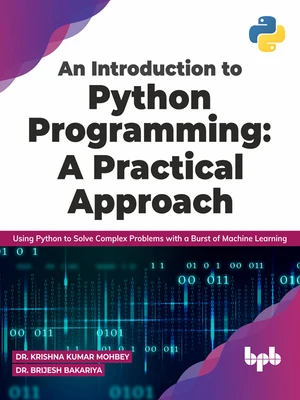step-by-step approach to Python programming with machine learning fundamental and theoretical principles. Key Features. ● Introduces readers to Python programming in a very simple way. ● Extensive practical demonstration of Python concepts using numerous examples. ● Implementation of machine learning in Python using hands-on techniques. Description. The book ‘Introduction to Python Programming: A Practical Approach’ lays out a path for readers who want to pursue a career in the field of computer software development. It covers the fundamentals of Python programming as well as machine learning principles. Students will benefit from the examples that are included with each concept, which will aid them in understanding the concept. This book provides a practical understanding of Python programming using numerous programs and examples. It also develops problem-solving and code-writing abilities for the readers. This book covers Python fundamentals, operators, and data structures such as strings, lists, dictionaries, and tuples. It also contains information on file and exception handling. The implementation of a machine learning model has also been included in this book.With the help of this book, students and programmers can improve their programming skills as well as their ability to sprint towards a rewarding career. What you will learn ● Learn Python concepts, operators, and data structures. ● Learn the properties and operations of lists, tuples, and dictionaries. ● Write Python code to solve specific issues. ● Write Python code to handle disk files and exceptions. ● Work with OOPS properties like classes, objects, constructors, inheritance, and polymorphism. Who this book is for. This book is intended for current and aspiring emerging technology professionals, students, and anyone else who wishes to better understand the Python programming language and machine learning concepts. Table of Contents 1. Chapter 1: Basics of Python Programming. 2. Chapter 2: Operators and Expressions. 3. Chapter 3: Control Flow Statements. 4. Chapter 4: Functions. 5. Chapter 5: Strings. 6. Chapter 6: Lists. 7. Chapter 7: Tuple. 8. Chapter 8: Dictionaries. 9. Chapter 9: File Handling. 10. Chapter 10: Exception Handling, Modules, and Packages. 11. Chapter 11: Object-oriented Programming. 12. Chapter 12: Machine Learning with Python. 13. Chapter 13: Clustering with Python. About the Authors Dr. Krishna Kumar Mohbey is an assistant professor of Computer Science at the Central University of Rajasthan, India. He completed his Ph.D. from the Department of Mathematics and Computer Applications from the National Institute of Technology Bhopal, India (2015). His areas of interest are machine learning, data mining, mobile web services, big data analysis, and user behavior analysis. He has authored three books on different subjects and published more than 25 research articles in reputed journals and conferences. LinkedIn Profile : https://in.linkedin.com/in/dr-k-k-mohbey-78947448. Dr. Brijesh Bakariya is working as an assistant professor for the Department of Computer Science and Engineering, I.K. Gujral Punjab Technical University (IKGPTU) Jalandhar (Punjab). He completed his Ph.D. degree from Maulana Azad National Institute of Technology (NIT- Bhopal), Madhya Pradesh (2016). He has authored 01 books and published more than 15 research papers in the journals of international repute in areas of data mining, image processing, machine learning, etc. LinkedIn Profile : https://www.linkedin.com/in/brijesh-bakariya-72b0237a
Price history
Oct 2, 2022
€12.77

